Related Research Articles
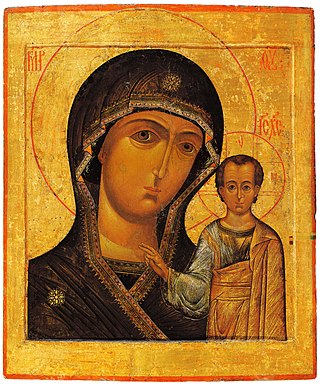
Theotokos is a title of Mary, mother of Jesus, used especially in Eastern Christianity. The usual Latin translations are Dei Genitrix or Deipara. Familiar English translations are "Mother of God" or "God-bearer" – but these both have different literal equivalents in Greek, Μήτηρ Θεοῦ and Θεοφόρος.

A prayer rope is a loop made up of complex woven knots formed in a cross pattern, usually out of wool or silk. The typical prayer rope has thirty-three knots, representing the thirty-three years of Christ's life. It is employed by monastics, and sometimes by others, to count the number of times one has prayed the Jesus Prayer.
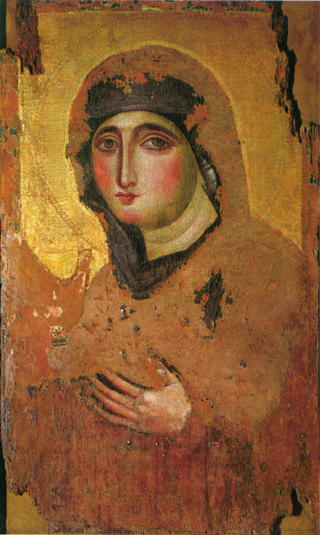
Mary was a first-century Jewish woman of Nazareth, the wife of Joseph and the mother of Jesus. She is a central figure of Christianity, venerated under various titles such as virgin or queen, many of them mentioned in the Litany of Loreto. The Eastern and Oriental Orthodox, Church of the East, Catholic, Anglican, and Lutheran churches believe that Mary, as mother of Jesus, is the Mother of God. Other Protestant views on Mary vary, with some holding her to have lesser status.

The Hail Mary or Angelical salutation is a traditional Catholic prayer addressing Mary, the mother of Jesus. The prayer is based on two biblical passages featured in the Gospel of Luke: the Angel Gabriel's visit to Mary and Mary's subsequent visit to Elisabeth, the mother of John the Baptist. It is also called the Angelical Salutation, as the prayer is based on the Archangel Gabriel's words to Mary. The Hail Mary is a prayer of praise for and of petition to Mary, regarded as the Theotokos. Since the 16th century, the version of the prayer used in the Catholic Church closes with an appeal for her intercession. The prayer takes different forms in various traditions and has often been set to music.
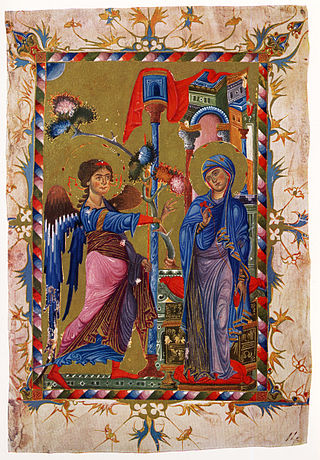
The Annunciation is, according to the Gospel of Luke, the announcement by the archangel Gabriel to Mary that she would conceive and bear a son through a virgin birth and become the mother of Jesus Christ, the Christian Messiah and Son of God, marking the Incarnation. Gabriel told Mary to name her son Jesus.
In the Eastern Orthodox Church, the feast of the death and Resurrection of Jesus, called Pascha (Easter), is the greatest of all holy days and as such it is called the "feast of feasts". Immediately below it in importance, there is a group of Twelve Great Feasts. Together with Pascha, these are the most significant dates on the Orthodox liturgical calendar. Eight of the great feasts are in honor of Jesus Christ, while the other four are dedicated to the Virgin Mary — the Theotokos.

Panagia, in Medieval and Modern Greek, is one of the titles of Mary, mother of Jesus, used especially in Eastern Catholicism and Orthodox Christianity.
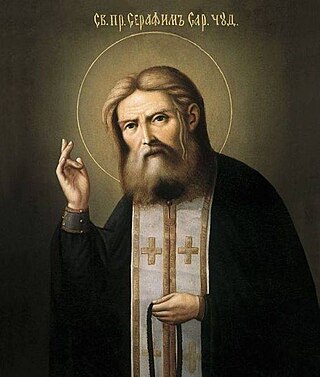
Seraphim of Sarov, born Prókhor Isídorovich Moshnín (Mashnín) [Про́хор Иси́дорович Мошни́н (Машни́н)], is one of the most renowned Russian saints and is venerated in the Eastern Orthodox Church and the Anglican Communion. He is generally considered the greatest of the 18th-century startsy (elders). Seraphim extended the monastic teachings of contemplation, theoria and self-denial to the layperson. He taught that the purpose of the Christian life was to receive the Holy Spirit. Perhaps his most popular quotation amongst his devotees is "acquire a peaceful spirit, and thousands around you will be saved."

Eucharistic discipline is the term applied to the regulations and practices associated with an individual preparing for the reception of the Eucharist. Different Christian traditions require varying degrees of preparation, which may include a period of fasting, prayer, repentance, and confession.

Lestovka is a special type of prayer rope made of leather, once in general use in old Russia, and is still used by Russian Old Believers today, such as the Russian Orthodox Christians and Russian Orthodox Oldritualist Church, Pomorian Old-Orthodox Church and edinoverians.
The Intercession of the Theotokos, or the Protection of Our Most Holy Lady Theotokos and Ever-Virgin Mary, is a Christian feast of the Mother of God celebrated in the Eastern Orthodox and Byzantine Catholic Churches on October 1 . The feast celebrates the protection afforded the faithful through the intercessions of the Theotokos.
An Akathist or AcathistHymn is a type of hymn usually recited by Eastern Orthodox and Byzantine Catholic Christians, dedicated to a saint, holy event, or one of the persons of the Holy Trinity. The name derives from the fact that during the chanting of the hymn, or sometimes the whole service, the congregation is expected to remain standing in reverence, without sitting down, except for the aged or infirm.

Marian devotions are external pious practices directed to the person of Mary, mother of God, by members of certain Christian traditions. They are performed in Catholicism, High Church Lutheranism, Anglo-Catholicism, Eastern Orthodoxy and Oriental Orthodoxy, but generally rejected in other Christian denominations.
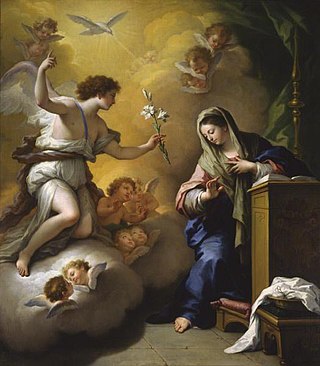
The Feast of the Annunciation commemorates the visit of the archangel Gabriel to the Virgin Mary, during which he informed her that she would be the mother of Jesus Christ, the Son of God. It is celebrated on 25 March; however, if 25 March falls either in Holy Week or in Easter Week, the feast is postponed to the Monday after the Second Sunday of Easter.
Eastern Orthodox worship in this article is distinguished from Eastern Orthodox prayer in that 'worship' refers to the activity of the Christian Church as a body offering up prayers to God while 'prayer' refers to the individual devotional traditions of the Orthodox.

The icon of Our Lady of the Sign or Platytera is the term for a particular type of icon of the Theotokos, facing the viewer directly, depicted either full length or half, with her hands raised in the orans position, and with the image of the Child Jesus depicted within a round aureole upon her breast.

Rosary-based prayers are Christian prayers said on a set of rosary beads, among other cords. These prayers recite specific word sequences on the beads that make up the different sections. They may be directed to Jesus Christ, the Virgin Mary or God the Father.
Marian feast days in the liturgical year are celebrated in honour of the Blessed Virgin Mary. The number of Marian feasts celebrated, their names can vary among Christian denominations.
Lutheran Mariology or Lutheran Marian theology is derived from Martin Luther's views of Mary, the mother of Jesus and these positions have influenced those taught by the Lutheran Churches. Lutheran Mariology developed out of the deep Christian Marian devotion on which Luther was reared, and it was subsequently clarified as part of his mature Christocentric theology and piety. Lutherans hold Mary in high esteem, universally teaching the dogmas of the Theotokos and the Virgin Birth. Luther dogmatically asserted what he considered firmly established biblical doctrines such as the divine motherhood of Mary while adhering to pious opinions of the Immaculate Conception and the perpetual virginity of Mary, along with the caveat that all doctrine and piety should exalt and not diminish the person and work of Jesus Christ. By the end of Luther's theological development, his emphasis was always placed on Mary as merely a receiver of God's love and favour. His opposition to regarding Mary as a mediatrix of intercession or redemption was part of his greater and more extensive opposition to the belief that the merits of the saints could be added to those of Jesus Christ to save humanity. Lutheran denominations may differ in their teaching with respect to various Marian doctrines and have contributed to producing ecumenical meetings and documents on Mary.